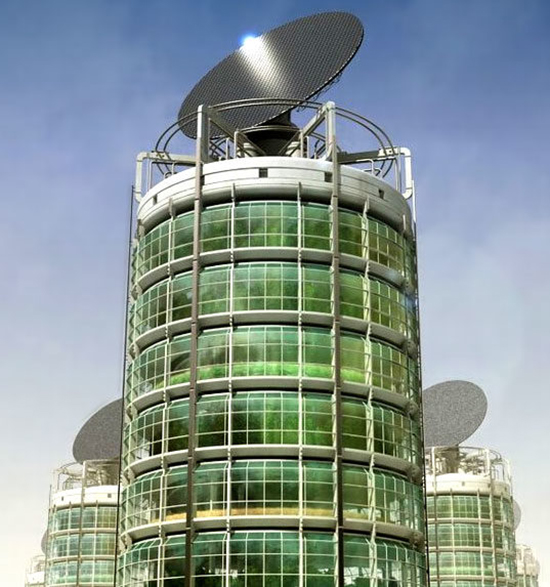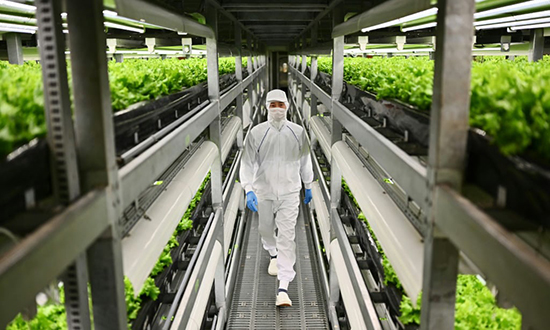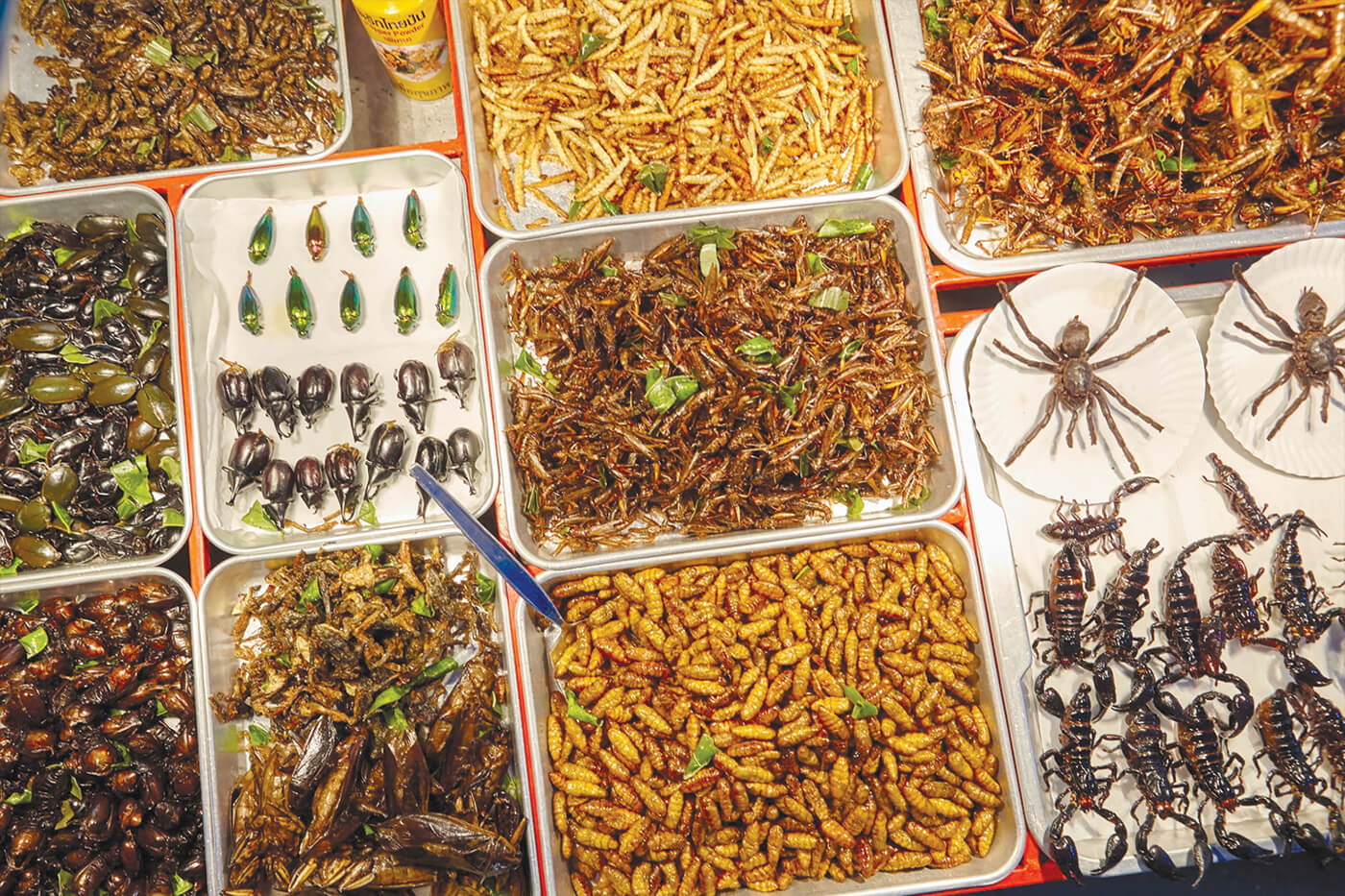Farmers in Lab CoatsI am tired of all the dystopian, doomsday pundits. As a Futurist, I am reporting to you, dear Readers, there is a lot to look forward to. Good things are happening in the vastly un-reported world of positive news. One particular area I find very exciting is Vertical Farming (VF), a method of growing crops indoors, under artificial conditions of light and temperature. It aims at higher productivity in smaller spaces. It uses soil-less methods such as hydroponics, aquaponics and aeroponics, according to John Turner, farmer and administrator of goruralforbusiness.com.
Hydroponics is a method of growing plants without soil. Plants need water and nutrients, both of which they can get from soil. They can also grow with their roots in a solution of water and nutrients, without soil.
Aquaponics is a combination of growing fish and other aquatic animals and hydroponics, growing plants without soil. Plants eat the animal discharges that bacteria in their roots break down, fertilizing themselves and cleaning the water at the same time, which goes back to the fish.
Aeroponics is the process of growing plants in thin air where its roots are exposed to nutrient packed mist. No soil or aggregate medium is used to support the plant. According to aeroponicsdiy.com, it is the fastest way to grow plants.
In VF, racks of plants are stacked over each other as high as your system will allow. Every rack can have its own irrigation, ventilation, lighting, and remote monitoring systems for a perfect yield every growth cycle.
VF can be done in large warehouses, abandoned factories, tall buildings, greenhouse-type enclosures, shipping containers, single rooms even on your kitchen windowsill!
A Little History
The practice of vertical farming goes back as far as the Hanging Gardens of Babylon in 600 B.C., according to Mark Crumpacker, who writes about ÔÇ£vaulted terraces, stacked one on top of the other, and planted with many different types of trees and flowers. Reaching a height of 20 meters, the gardens were likely irrigated by an early engineering innovation known as a chain pump, which would have used a system of buckets and pulleys to bring water from the Euphrates River at the foot of the gardens to a pool at the top.ÔÇØ
During the so-called Dark Ages, Crumpacker writes, ÔÇ£Aztec people used a form of hydroponic farming known as chinampas to grow crops in marshy areas near lakes. Since the swampy soil in these areas was not suitable for agriculture, the Aztecs instead constructed rafts out of reeds, stalks, and roots, covered the rafts with mud and soil from the lake bottom, and then drifted them out into the lake. Due to the structural support provided by the rafts, crops could grow upwards while their roots grew downwards through the rafts and into the water. Often, many of these individual rafts were attached together to form expansive floating ÔÇ£fields.ÔÇØ
Dickson Despommier of Columbia University published ÔÇ£The Vertical Farm: feeding the world in the 21st CenturyÔÇØ in 2010, in an effort to address the need to feed growing urban populations, using tall buildings and rooftop gardens.A strong proponent of veritical farming, Despommier understood that this type of crop productionÔÇÖs time had come.
An interesting note in the history of vertical varming: Along with Greenhouse Gardening and NASAÔÇÖs drive to develop technologies to grow crops in space, the production of illegal cannabis contributed greatly to the technology of VF. Gabe Blanchett, co-founder of Grove, writes, ÔÇ£Many indoor growing technologiesÔÇöfrom high pressure (HPS) sodium lighting to metal halide lighting to LED grow lighting to specially formulated nutrient blends to rootzone technologies like rockwool, hydroponics, plus aeroponics, even beneficial mycorrhizal fungi inoculantsÔÇöwere developed, improved, and marketed for cannabis growers, driving innovation in hydroponics and aeroponics, mostly in secrecy.ÔÇØ Virtual farming aims at higher productivity in smaller spaces using soil-less methods such as hydroponics, aquaponics and aeroponics. The first VF in Singapore. |
 VF can be done in skyscrapers, abandoned factories, tall buildings, greenhouses, shipping containers, single rooms, even on your kitchen windowsill! Advantages/Disadvantages of Vertical Farming
Seventy percent of the fresh water used on Earth is used for cultivation. VF reduces that by 70-95%. Holy water! Pesticides and insecticides are unnecessary, so there is no polluting runoff into streams, rivers, lakes, and oceans. Pests, such as insects, soil fungi, etc., are virtually eliminated. Adverse weather conditions do not affect crop production. LED and climate control insure year-round crop production.
Another plus with VF is that food can be grown right in the middle of large cities and delivered super-fresh to markets, which also reduces the carbon footprint of shipping food long distances. Because crops are stacked vertically, the amount of land necessary to produce vast quantities of fresh food is tremendously lessened. An acre of Vertically Farmed crops could produce 20 acres worth of tilled acreage and more, in skyscrapers.
The cost of producing food goes way down after the initial set up. VF takes much less labor. and there would be less cause for destruction of wildlife habitat. Energy could be produced from composted waste and it would no longer be necessary to produce or operate massive diesel-burning farm machinery.
A couple of disadvantages include the present lack of skilled labor, including engineers, the maintenance of growing solutions, machinery, cultivation, and harvesting equipment. It also requires precise supervision of its elements. Pollination of plants, at this point, has to be manual, which is labor intensive and costly. The dependence on technology could result in catastrophic crop loss if the power goes out, even for a day. Finally, current farming communities could face hard times reinventing themselves in the face of urban farming competition.
The Future of Vertical Farming
Using 2050 as the population benchmark of the future, it is predicted that nine billion people worldwide will need feeding by then.VF is still in its infancy, but it shows great promise in feeding a hungry world in an environmentally benign way. I think a great Christmas gift would be a little hydro, aqua or aeroponics set up. Home VF would be a fun project and a great skill to learn. Who knows? Residences of the future may have their own vVFrooms built in and people may grow their own produce right next to their kitchens!
Right now, straddling the past and the future, I am going outside to water the garden we, as Topangans, are blessed to have in the middle of this vast megalopolis of Los Angeles. I will pull weeds, remove pests, grab a crisp, sweet, home-grown apple and mourn the loss of a lettuce to some nighttime visitor with whom we share our crops.
Vamos a Ver!  | | | | | | | | | | | | | | |
|
|
|
|
|













